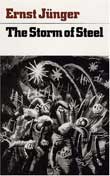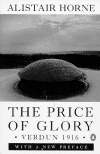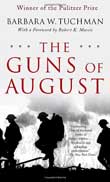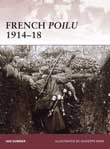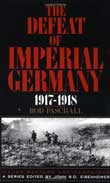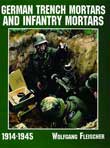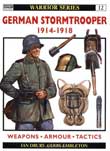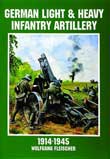

A memoir of astonishing power, savagery, and ashen lyricism, Storm of Steel illuminates not only the horrors but also the fascination of total war, seen through the eyes of an ordinary German soldier. Young, tough, patriotic, but also disturbingly self-aware, Jünger exulted in the Great War, which he saw not just as a great national conflict but—more importantly—as a unique personal struggle. Leading raiding parties, defending trenches against murderous British incursions, simply enduring as shells tore his comrades apart, Jünger kept testing himself, braced for the death that will mark his failure. Published shortly after the war’s end, Storm of Steel was a worldwide bestseller.
Storm of Steel begins with Jünger as a private entering the line with the 73rd Hanoverian Regiment (7./F.R.73) in Champagne. His first taste of combat came at Les Éparges in April 1915 where he was first wounded.
After recuperating, he took an officer's course and achieved the rank of Ensign. He rejoined his regiment on the Arras sector. In 1916, with the Battle of the Somme underway, Jünger's regiment moved to Combles in August for the defence of the village of Guillemont. Here Jünger was wounded again, and fortunately absent shortly before the final British assault which captured the village—his platoon was annihilated. In 1917 Jünger saw action during the Battle of Arras in April, the Third Battle of Ypres in July and October, and the German counter-attack during the Battle of Cambrai in November. Jünger led a company of assault troops during the final German Spring Offensive, 21 March 1918 when he was wounded again. On 23 August he suffered his most severe wound when he was shot through the chest.
In total, Jünger was wounded 14 times during the war, including five bullet wounds. He was awarded the Iron Cross 1st Class and was the youngest, and last, ever recipient of the Pour le Mérite
The "Price of Glory: Verdun 1916" is the second book of Alistair Horne's trilogy, which includes "The Fall of Paris" and "To Lose a Battle" and tells the story of the great crises of the rivalry between France and Germany. The battle of Verdun lasted ten months. It was a battle in which at least 700,000 men fell, along a front of fifteen miles. Its aim was less to defeat the enemy than bleed him to death and a battleground whose once fertile terrain is even now a haunted wilderness. Alistair Horne's classic work, continuously in print for over fifty years, is a profoundly moving, sympathetic study of the battle and the men who fought there. It shows that Verdun is a key to understanding the First World War to the minds of those who waged it, the traditions that bound them and the world that gave them the opportunity. "Verdun was the bloodiest battle in history..."The Price of Glory" is the essential book on the subject". ("Sunday Times"). "It has almost every merit...Horne sorts out complicating issues with the greatest clarity. He has a splendid gift for depicting individuals". (A.J.P. Taylor, "Observer"). "A masterpiece". ("The New York Times"). "Compellingly told...Alastair Horne uses contemporary accounts from both sides to build up a picture of heroism, mistakes, even farce". ("Sunday Telegraph"). "Brilliantly written ...very readable; almost like a historical novel - except that it is true". (Field Marshal Viscount Montgomery). One of Britain's greatest historians, Sir Alistair Horne, CBE, is the author of a trilogy on the rivalry between France and Germany, "The Price of Glory", "The Fall of Paris" and "To Lose a Battle", as well as a two-volume life of Harold Macmillan.
In this Pulitzer Prize-winning history, Tuchman writes about the turning point of the year 1914—the month leading up to the war and the first month of the war. This was the last gasp of the Gilded Age, of Kings and Kaisers and Czars, of pointed or plumed hats, colored uniforms, and all the pomp and romance that went along with war. How quickly it all changed, and how horrible it became. Tuchman is masterful at portraying this abrupt change from 19th to 20th Century. And how she manages to make the story utterly suspenseful, when we already know the outcome, is the mark of a great writer, and a classic volume of history.
Praise for The Guns of August
“A brilliant piece of military history which proves up to the hilt the force of Winston Churchill’s statement that the first month of World War I was ‘a drama never surpassed.’”—Newsweek
“More dramatic than fiction . . . a magnificent narrative—beautifully organized, elegantly phrased, skillfully paced and sustained.”—Chicago Tribune
“A fine demonstration that with sufficient art rather specialized history can be raised to the level of literature.”—The New York Times
“[The Guns of August] has a vitality that transcends its narrative virtues, which are considerable, and its feel for characterizations, which is excellent.”—The Wall Street Journal
'Why,' the Kaiser enquired of Czar Nicholas in 1913, did he wish to ally himself with France when 'the Frenchman is no longer capable of being a soldier?' Indeed, during World War I (1914-1918) the French Army was in a state of disarray, plagued by indiscipline, mutinies and desertion. The ordinary French citizens that were called upon to defend their motherland, the Poilu, were disrespected and demoralized, and the infamous mutinies of 1917 by the Poilu were not protests against the war itself, but against how the war was conducted. The rebellions sent a stark warning, forcing a reform in the management of the war. Consequently, the performance of many French regiments improved and the Poilu went on to become the only European troops to fight the entire war within their own borders. Ian Sumner expertly charts the history of the Poilu, from the conscription of hundreds of thousands of men, through their training, to the horrors of the trenches and the fear of no-man's land, providing a fascinating insight into the events that led to the 1917 revolts. New artwork and diagrams illustrate the experiences of the soldiers as the comforts of civilian life were stripped away from them and the trenches became their homes.
This book goes a long way towards showing how many of the conventional beliefs concerning WW1 are totally innaccurate. He dosen't diminish the loss of life but he does show that the generals in charge were no less capable than their WW2 counterparts. Much of what was practiced in WW2 started in WW1. Pascall builds a compelling case that the generals on both sides invented ingenious new strategies that simply failed in the context of a war of attrition. An outstanding contribution to the body of knowledge of World War One.
January 1917. On the Western Front the armies of Imperial Germany, Great Britain, and France were locked in grim stalemate. Repeated attempts by both sides to achieve breakthrough in the face of machine-gun fire, barbed wire, long-range artillery, and poison gas had brought only enormous casualties.The Defeat of Imperial Germany focuses on the innovative plans created by generals on both sides in their struggles to dislodge the entrenched enemy and to restore maneuver and victory on the Western Front. In a series of vivid analyses of successive offensives, Paschall examines the problems of command and what happened when the massed soldiery sought to carry out their orders. These strategies and tactics developed by the military leadership in 1917–1918, though largely failing to shatter the deadlock, would prove successful when implemented twenty years later in World War II.The first volume in the Major Battles and Campaigns series published under the general editorship of John S.D. Eisenhower, The Defeat of Imperial Germany has been designed for the "armchair strategist." Dozens of photographs, many never before published, as well as clearly drawn theater and battlefield maps help to make this book an outstanding, challenging, and original contribution to the history of the Great War.
Shown are the various caliber mortars used by the German infantry during World Wars I & II., over 70 b/w photographs, 8 1/2" x 11"
Okay, I bought this book (used) a few years back. It's okay, but has some inaccuracies. If you need a basic primer on the Sturmtruppen, then buy it... it's not that bad.
The first official German stormtroop unit was authorized on 2 March 1915 when the Supreme Command of the field army ordered the VIII Corps to form a detachment for the testing of experimental weapons and the development of approximate tactics that could break the deadlock on the Western Front. By the summer of 1915, stormtroop units were springing up throughout the German armies in the west, and by the end of 1916 official stormtroop battalions were established throughout the western armies, providing a deadly new threat for the Allies. This book examines the uniform, equipment and tactics of Germany's feared elites of World War I (1914-1918).
Reviewer: Mal Wright from Adelaide, South Australia.
This booklet, by Wolfgang Fleischer, is a bit misleading as the title leads one to expect more coverage of WW1. Instead it skips over the 1914-18 period and seems to use it more as an introduction to WW2. That is a shame as even though it does not mention many WW1 guns, those it does skip across are interesting weapons. After a couple of pages of fairly vague text on WW1 it goes into WW2 infantry guns in considerably more detail. Once again it is often tempting, but not very fulfilling. However the photographic coverage of WW2 Infantry guns is quite extensive. It should prove helpful to those wanting to model some of the weapons in detail and at the price is therefore a bargain. As a serious work on the subject, it is however lacking in technical data and comparisons. I give this booklet 3 stars for WW2 and would give it half a star for WW1. It is worth adding to your collection and won't break your budget.
Roman Lower Rhine army proclaims its commander, Vitellius, Emperor
John II begins his reign as Catholic Pope
Emperor Joseph II orders Jews of Galicia Austria to adopt family names
Spain recaptures Granada from the Moors (Granada Day)
Tsar Ivan the Terrible march to Novgorod begins
Spain and Catholic France sign Saint League of Joinville
Battle at Kinsale, Ireland: English army beats Spanish
Spanish force in Ireland surrender to the English at Kinsdale
Staatsoper Hamburg opens with Theiles "Adam und Eva"
British troops occupy Calcutta India
1st revolutionary flag displayed
Austria ends interregation torture
Georgia is 4th state to ratify US constitution
Free black community of Philadelphia petitions Congress to abolish slave
US Sen Thomas Pickering is 1st senator censured (revealed confidential documents communicated by the President of the US)
Liberator, abolitionist newspaper, begins publishing in Boston
1st Curling club in US (Orchard Lake Curling Club) opens
1st photo of the Moon (French photographer Louis Daguerre)
1st US wire suspension bridge for general traffic opens in Penn
Colonel Charles Stone is put in charge of organizing DC militia
SC seizes inactive Ft Johnson in Charleston Harbor
Construction of Brooklyn Bridge begins
King Amadeus I of Spain inaugurated at 25
1st Test match hat-trick, Fred Spofforth at the MCG
British battleship Thunder explodes in Gulf of Ismid, 9 die
Dr Benjamin E Mays, named President of Atlanta Board of Education
Northwestern League (minor baseball league) organized, Rockford, Illinois
Because of anti-monopoly laws, Standard Oil is organized as a trust
Gen Wolseley receives last distress signal of General Gordon in Khartoum
Alice Sanger becomes 1st female White House staffer
1st US commemoratives and 1st US stamp to picture a woman issued
Battle at Doornkop, South Africa (Boers beat Dr Jamesons troops)
E Verlinger begins manufacturing 7" single-sided records (Montreal)
Gustave Charpentiers opera "Louise, " premieres in Paris
President Roosevelt shuts down post office in Indianola Miss, for refusing to accept its appointed postmistress because she was black
Elara, a satellite of Jupiter, discovered by Perrine
Japanese troops capture Port Arthur
Canadian branch of the Royal Mint opens in Ottawa
1st official Dutch 11 city skate (Minne Hoekstra in 13:50)
1st junior high schools in US opens (Berkeley, California)
Brooklyn Dodgers President Charles Ebbets announces purchase of grounds to build a new concrete-and-steel stadium to seat 30,000
Philips installs research department in Eindhoven
Dodgers trade Casey Stengel and Cutshaw to Pittsburgh for Grimes and Mamaux
NHL Montreal Wanderers disband after Westmount arena burns down
Anti-British uprising in Ireland
Lithuania gains independence
10,000 US union and socialist organizers arrested (Palmer Raids)
1st religious service radio broadcast in US, KDKA-Pittsburgh
DeYoung Museum in Golden Gate Park opens
Ku Klux Klan surprise attack on black residential area Rosewood Florida, 8 killed (compensation awarded in 1995)
Gorno-Badakhshan Autonomous Region established (now in Tadzhik SSR)
US and Canada agree to preserve Niagara Falls
Young gang shoot dead 6 police in Springfield, Missouri
Bruins beat Rangers in New York 13-3
Ijmuider fishing strike begins (till July 11th)
US troops leave Nicaragua
1st state liquor stores open, in Pennsylvania
Bradman scores 253 NSW vs. Queensland, 204 mins, 29 fours 4 sixes
Bruno R Hauptmann trial begins for kidnap-murder of Lindbergh baby
1st electron tube to enable night vision described, St. Louis, Missouri
Bradman scores 357 for South Africa vs. Victoria, 424 minutes, 40 fours
Book publisher Simon and Schuster founded
Bradman scores 107 South Africa vs. Victoria, his 4th consecutive century
28 nations, at war with Axis, pledge no separate peace
German troops in Bardia surrender
Japanese troops occupy Manila Philippines
1st use of helicopters during warfare (British Atlantic patrol)
Allied air raid on Neurenberg
Kentucky begins 130 home basketball game win streak, ends in 1955
Radio Orange ends cooperation at Liese-Aktion
Mahatma Gandhi begins march for peace in East-Bengali
WNDT (now WNET) TV channel 13 in New York-Newark, New York (PBS) begins
KDKA TV channel 2 in Pittsburgh, PA (CBS) begins broadcasting
"Pal Joey" opens at Broadhurst Theater NYC for 542 performances
NBA Baltimore Bullets begin a 32 game road losing streak
Herman Wouks "Caine Mutiny, " premieres in New York City
1st "Bob Cummings Show" premieres on NBC (later on CBS)
Poujadists / communists win French parliamentary elections
USSR launches Mechta (Luna 1) for 1st lunar fly-by, 1st solar orbit
Cuban Dictator Fulgencio Batista flees
1st redshank old world shore bird reported in North America (Halifax)
John F Kennedy announces run for US Presidency
John Reynolds sets age of solar system at 4,950,000,000 years
Senator John F Kennedy, announces his candidacy for President
1st AFL Championship Game, Houston Oilers beat LA Chargers 24-16
Nighttime version of "Password" with Allen Ludden premieres on CBS
Ayub Khan elected President of Pakistan
Failed assassination attempt on President Nkrumah of Ghana
Martin Luther King Jr begins a drive to register black voters
New York Jets sign quarterback Joe Namath
Obverse design of all Canadian coins is changed to depict present-day
1st Jewish child born in Spain since 1492 expulsion
Green Bay Packers beat Cleveland Browns 23-12 in NFL championship game
"Zizi" closes at Broadway Theater NYC after 49 performances
Christian Barnard performs 2nd heart transplant
KBHK TV channel 44 in San Francisco, CA (IND) begins broadcasting
"Fig Leaves Are Falling" opens at Broadhurst Theater NYC for 4 performances
"Soviet Sport" calls Emile Zatopek a public enemy
Dutch premiere of musical "Hair" in Amsterdam
US population is 293,200,000; Black population: 22,600,000 (11.1%)
A barrier collapses at Ibrox Park football ground at end of a soccer match in Glasgow Scotland, killing 66
"Rothschilds" closes at Lunt-Fontanne Theater NYC after 505 performances
Mariner 9 begins mapping Mars
Miami Dolphins beat Baltimore Colts 21-0 in AFC championship game
55 mph speed limit imposed by Richard Nixon
Worst fire in Argentine history destroys 1.2 million acres
US Department of Interior designates grizzly bear a threatened species
Bowie Kuhn suspends Braves owner Ted Turner for one year due to tampering charges in Gary Matthews free-agency signing
Rhino Records releases their 1st album "Wildmania"
30th Islander shut-out opponent-Glenn Resch 9-0 vs. Vancouver
Gavaskar gets twin tons for India for the third time (vs. West Indies)
68th Australian Men Tennis: Guillermo Vilas beat John Sadri (76 63 62)
Mary Terstegge Meagher swims female record 200 m butterfly (2:05.65)
Sylvester Clarke knocks out spectator with brick, WI vs. Pakistan
"Camelot" closes at Winter Garden Theater NYC after 48 performances
70th Australian Mens Tennis: Johan Kriek beats S Denton (62 76 67 64)
Islanders start 23 undefeated home streak (21-0-2) 14 straight wins
SD Chargers beat Miami Dolphins, 41-38 in 13:52 of OT
"Annie" closes at Alvin Theater NYC after 2,377 performances
"Sophisticated Ladies" closes at Lunt-Fontanne NYC after 767 performances
Don Muraco beats Pedro Morales to become WWF Intercontinental Champ
Gary Trudeau takes a 20-month break from writing "Doonesbury"
Ken Anderson of Cincinnati completes record 20 consecutive passes
Miami beats Nebraska in Orange Bowl for college football championship
Riot in Tunis kills over 100
90th hat trick in Islander history-Brent Sutter
Australia beat WI by innings at SCG, Bob Holland 10 match wkts
Egyptian President Mubarak reappoints Coptic Pope Shenuda III
Nevada-Las Vegas beats Utah 142-140, highest college basketball score
Undefeated BYU becomes college football champions
191.66 million shares traded in New York Stock Exchange
New York Islander, Mike Bossy, scores his 500th goal
Penn State upsets Miami in Fiesta Bowl for college football champ
Ashland Oil storage tank spills 3.8 million gallons, Penn
Mulroney and Reagan sign Canada-US free trade agreement
Notre Dame beats West Virginia for college football championship
UCLA wins a record 7th consecutive bowl game
Dow Jones hits record 2,800 (2,810.15)
Sting joins wrestlings 4 Horsemen (Flair, Arn Anderson, Ole Anderson)
Colorado wins its 1st AP national title poll
Test debut of Shane Warne, vs. India at Sydney
"Gypsy Passion" closes at Plymouth Theater NYC after 55 performances
"Abe Lincoln in Illinois" closes at Beaumont NYC after 40 performances
"Shakespeare after My Father" closes at Helen Hayes NYC after 266 performances
Battles between army and rebellious indians in South Mexico, kill 57
Bus crashes in Luzon Philippines, 29 killed
Carquest Bowl 5: South Carolina beats West Virginia, 24-21
Most distant galaxy yet discovered found by scientists using Keck telescope in Hawaii (est 15 billion light years away)
Howard Stern Radio Show premieres in Columbus OH on WBZX 99.7 FM
Autopsy of Chris Farley shows he overdosed of opiates and cocaine
